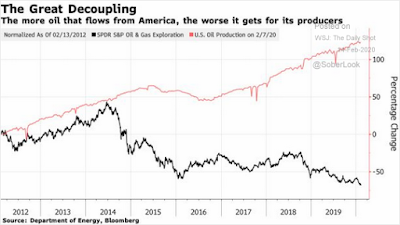Price Maker vs. Price Taker, Part I
Any arguments on that point are now moot, in my opinion. The definition of price maker and of price taker are provided at the links by Investopedia. Further analysis of why there are no substitutes for oil and gas, please review our White Paper.
The Preliminary Specifications decentralized production models key feature is its price maker strategy. Shifting the current industry belief that oil and gas commodities are price takers to the appropriate footing of price makers. This graph shows that the more oil production that came onto the market the more value eroded from the industry due to the chronic overproduction and oversupply. Fundamentally destroying the prices of oil and gas, and subsequently the producers themselves. If these commodities were price takers, then in this situation the increased production volumes would have had no effect on the price of the product. Whereas one of the characteristics of price makers sees significant price responses to small increases or decreases in production. The bureaucrats misguided belief that oil and gas are price takers is systemic and unanimous in the industry, and is clearly incorrect. The only method to resolve the situation is the industry wide implementation of the Preliminary Specification in order that our decentralized production models price maker strategy can take effect throughout.
One of the first requirements we do in the implementation of the Preliminary Specification is to move the accounting focus away from the corporate model as we describe it, to the Joint Operating Committee. Then each property can begin to have their own financial statements prepared to find out if it is profitable in the real sense of the word. Accurately measuring the timing of capital costs, royalties, operating costs and actual overhead incurred to ensure that the performance of the property is providing incremental value to the corporations that own them. This requires in addition to changing the recognition of depletion to the property level or Joint Operating Committee for each producer, overhead will need to be charged directly to the individual Joint Operating Committees. These are the two critical changes that are made in the Preliminary Specification in comparison to today’s accounting. First we’ll need to have People, Ideas & Objects software define and support an alternative industry and producer organizational structure. One where the administrative and accounting resources are reallocated from the individual producer firms to the service providers that are established through the Preliminary Specification. Through the reorganization of the industry our user communities service provider organizations will be providing their process management service to the entire industry for the specific process or subprocess they manage. It is in that way that they’ll attain high levels of specialization of that process and the division of labor will be distributed over the approximate 3 thousand service providers that People, Ideas & Objects expects will be needed to cover off the full scope of administration and accounting of the oil and gas industry. Actual overhead of each of the properties will therefore be known based on the actual detailed accounting at each property. Overhead charges which will consist of the billings of each of the service providers who provided their process management to that Joint Operating Committee that month. Producers will no longer allocate direct overhead costs to the corporation with the subsequent capitalization of approximately 85% of those costs to property, plant and equipment. The same will be the case for overhead allowances to the Joint Operating Committee, they will be replaced by the actual direct overhead charged to the individual Joint Operating Committee.
The most immediate direct change as a result of managing overhead costs in this manner will be the benefit to the producers cash management. Ensuring the cash that was incurred to fund each month's overhead, which is up to 20% of revenue throughout the industry, is returned to the producer by way of the oil and gas prices they charge the consumers of their products. Creating a monthly float of cash being cycled each month to pay the firms overhead for the next month. This is the primary reason that cash and working capital continues to escape the producers grasp. Currently their capitalization of overhead policy has the majority of these costs capitalized. These costs are then depleted over the next number of decades providing the return of a small fraction of the cash that was consumed in overhead each month. As we now know this system only worked when there were investors ready and willing to recharge the spending machine each month. Either way it is foolish to manage an enterprise in this manner and the need for change is hypercritical. The inability of bureaucrats however, to absorb the facts contained in the Preliminary Specification have been well documented since it was published in December 2013. Six months before the oil price broke down in similar fashion to the way that natural gas did five years earlier. Note this return of cash will only occur if there is an accurate costing of the oil and gas commodities produced, that producers impose the inherent production discipline we’ll discuss on Wednesday, and therefore only profitable operations are undertaken. In essence invoking the price maker strategy of the decentralized production model within the Preliminary Specification.
The Preliminary Specification, our user community and service providers provide for a dynamic, innovative, accountable and profitable oil and gas industry with the most profitable means of oil and gas operations. Setting the foundation for profitable North American energy independence. People, Ideas & Objects have published a white paper “Profitable, North American Energy Independence -- Through the Commercialization of Shale.” that captures the vision of the Preliminary Specification and our actions. Users are welcome to join me here. Together we can begin to meet the future demands for energy. And don’t forget to join our network on Twitter @piobiz anyone can contact me at 403-200-2302 or email here.







